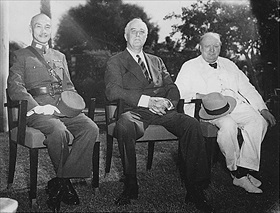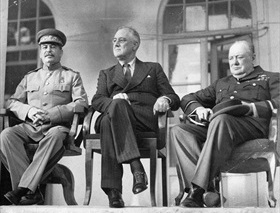ALLIES HOLD STRATEGY MEETINGS IN CAIRO, TEHRAN
Cairo, Egypt · November 24, 1943
On this date in 1943 in Egypt, U.S. President Franklin D. Roosevelt, British Prime Minister Winston Churchill, and Chinese leader Generalissimo Chiang Kai-shek continued their series of talks during their Cairo Conference (November 23–27, 1943). Churchill and his party had hoped to establish a way to deal with Soviet leader Joseph Stalin, who had declined an invitation to meet in Cairo, forcing the “Big Three” to meet in Tehran, Iran, at the end of the month.
From the British perspective, the Cairo meeting failed to achieve its aims. For one thing, Roosevelt, whose health was starting to deteriorate, was edgy and withdrawn; he ignored the Stalin issue and focused the talks mainly on building up Allied military forces in the Far East sufficient to force Japan’s unconditional surrender. The American, British, and Chinese leaders agreed to construct long-distance, heavy bomber bases in the China-Burma-India (CBI) Theater, and eventually 8 were built (4 in India and 4 in China), starting with Chengdu in Central China, starting with Chengdu in Central China, 1,500 miles/2,414 km from Japanese soil. (At the time of the conference, it was assumed by the American Joint Chiefs of Staff that Chinese land bases would provide the launching pad for a strategic bombing campaign against Japan, and by April 1944 the 8 operational bases were suitably advanced to begin nascent operations against Japanese interests using 4‑engine, heavy bomber B‑29 Superfortresses.) Churchill was clear that one of his primary war aims in the Far East was to restore Britain’s relationship with her colonies of Malaya, Burma, Hong Kong, and Singapore, all of which were now occupied by the Japanese enemy. Roosevelt opposed these aims and was even more opposed to risking American lives to shore up British interests anywhere outside the British Isles—Australian (Eastern) New Guinea (part of the British Commonwealth) notwithstanding.
In Tehran, where the 2 Western leaders were joined by Stalin, the 3 men committed themselves to opening a second front in France (Operation Overlord in Normandy and Operation Dragoon on the French Riviera) in conjunction with a Soviet attack on Germany’s eastern border (Operation Bagration). Expectation was that a second front would dissuade Adolf Hitler from moving any military forces from Eastern Europe to France.
Of long-lasting global significance were the various agreements in 1944 and 1945 reached by the Allied leaders and their representatives that nations in league with Germany and Italy would be divided into territories to be controlled after the war by the U.S., Great Britain, France, and the Soviet Union.
Major Allied Strategy Conferences, 1943–1945
 |  |
Left: Nationalist Chinese leader Chiang Kai-shek, U.S. President Franklin D. Roosevelt, and British Prime Minister Winston Churchill at the Cairo Conference (November 22–26, 1943) addressed the Allied position against Japan and the future of postwar Asia. The Cairo Declaration, issued on November 27, 1943, stipulated that “Japan be stripped of all the islands in the Pacific which she has seized or occupied since the beginning of the First World War”; “all the territories Japan has stolen from the Chinese, such as Manchuria and Formosa (Taiwan), shall be restored to the Republic of China”; and that in due course the Japanese colony of Korea “shall become free and independent.”
![]()
Right: The “Big Three” (left to right) Soviet premier Joseph Stalin, Roosevelt, and Churchill) on the portico of the Soviet Embassy during the Tehran Conference, November 28 to December 1, 1943. It was the first Allied conference Stalin attended, and it focused primarily on strategic coordination among the Allies. Discussions covered the postwar division of Germany. Ten months later at the Octagon Conference in September 1944 in Quebec, Canada, Roosevelt and Churchill, minus Stalin, agreed to divide vanquished Nazi Germany into occupation zones to ensure the transition of Germany into a peaceful nation-state when the occupying forces withdrew.
 |  |
Left: Held in Soviet Crimea between February 4 and 11, 1945, the Yalta summit was the first Allied conference that focused on the postwar world. All 3 Allies agreed on an Allied Control Commission to oversee defeated Germany. Germany and Austria, as well as their capitals, would eventually be divided into 4 occupation zones—U.S., British, Soviet, and French.
![]()
Right: With victory in Europe achieved, the Big Three (Stalin, Harry S. Truman representing the U.S. following Roosevelt’s death, and Clement Attlee representing Great Britain after defeating Churchill’s party in British elections) discussed the surrender terms for Japan during the Potsdam Conference, which was held near Berlin between July 17 and August 2, 1945. The Potsdam Declaration, issued on July 26, 1945, with China’s approval but not that of the still-neutral Soviet Union, affirmed the terms of the Cairo Declaration (November 27, 1943), but also required Japan’s unconditional surrender. Japanese sovereignty was limited to 4 main islands (Japan’s “Home Islands”), and the country was to be occupied by the U.S. Armed Forces.
Contemporary Newsreel of Big Three at Cairo and Tehran Conferences, 1943: Roosevelt, Churchill, Chiang Kai-shek, and Stalin
![]()

 History buffs, there is good news! The Daily Chronicles of World War II is now available as an ebook for $4.99 on Amazon.com. Containing a year’s worth of dated entries from this website, the ebook brings the story of this tumultuous era to life in a compelling, authoritative, and succinct manner. Featuring inventive navigation aids, the ebook enables readers to instantly move forward or backward by month and date to different dated entries. Simple and elegant! Click
History buffs, there is good news! The Daily Chronicles of World War II is now available as an ebook for $4.99 on Amazon.com. Containing a year’s worth of dated entries from this website, the ebook brings the story of this tumultuous era to life in a compelling, authoritative, and succinct manner. Featuring inventive navigation aids, the ebook enables readers to instantly move forward or backward by month and date to different dated entries. Simple and elegant! Click 











